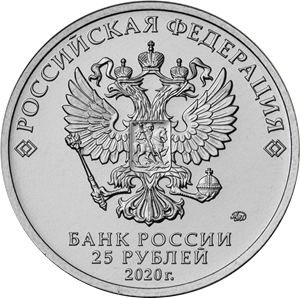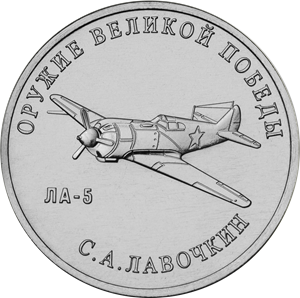Weapons Designer Semyon Lavochkin
Obverse
in the centre there is a relief image of the National Coat of Arms of the Russian Federation and over it a semicircular inscription along the rim: "РОССИЙСКАЯ ФЕДЕРАЦИЯ" (RUSSIAN FEDERATION) framed by doubled rhombuses on both sides, under the emblem, in three lines, there is an inscription: "БАНК РОССИИ" (BANK OF RUSSIA), the coin’s par value "25 РУБЛЕЙ" (25 RUBLES), and the year of issue "2020 г." (2020), and on the right there is a mint trade mark.
Reverse
a relief image of the La-5 fighter aircraft and the inscription‘ЛА-5’ (LA-5) on the left; along the rim there are the inscriptions ‘ОРУЖИЕ ВЕЛИКОЙ ПОБЕДЫ’ (WEAPONS OF THE GREAT VICTORY) at the top and ‘С.А. ЛАВОЧКИН’ (SEMYON LAVOCHKIN) at the bottom.
Authors
Designers: E.V. Kramskaya (obverse), A.V. Gnidin (reverse).
Sculptors: A.A. Dolgopolova (obverse), computer simulation (reverse).
Mint: Moscow Mint (ММД).
Edge: 180 corrugations.
Discover more
Semyon Alekseyevich Lavochkin (1900–1960) was a Soviet aircraft designer who oversaw the creation of the La-5 fighter aircraft, which was deployed in 1942.
The La-5 was based on another fighter, the LaGG-3, which Lavochkin had designed in 1940, together with V.P. Gorbunov and M.I. Gudkov. The LaGG-3 had seen combat at the start of the Great Patriotic War. The La-5’s predecessor was a rather unusual aircraft: it was made entirely of wood, including an innovative, exceptionally durable wood-based material called ‘delta wood’; this allowed the circumvention of the dire lack of aluminium and the quick launch of mass production.
Still, the LaGG-3 was rather inferior to the latest modifications of enemy fighter aircraft. Therefore, a decision was made in 1942 to improve the model as soon as possible, by installing a more powerful engine. And thus the legendary La-5 was born; it retained its predecessor’s wooden hull, but gained a better engine, which significantly improved its flight performance. The new craft was faster, easier to manoeuvre, and more reliable; this, together with powerful weapons, turned the La-5 into a most formidable adversary for the German fighters.


